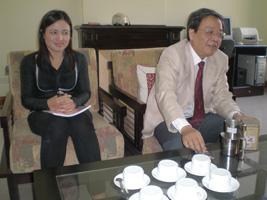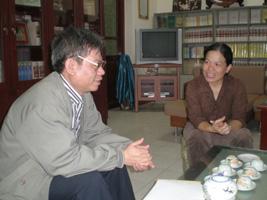
Bui Viet Hoa in Finland for the first time in 1986
In the last several years, Bui Viet Hoa has continued her studies in Hungary and written her doctoral research about the similarities and differences between Vietnamese folk poetry and the folk poetry behind the Kalevala.
During the period when she was translating the Kalevala, Bui Viet Hoa made several visits to the poetry villages of Viena, where the bulk of the Kalevala poetry material was recorded. After M. A. Castrén, she was the first Kalevala translator to spend time in Viena. While she was translating she became very familiar with the methods by which Lönnrot created all five different versions of the Kalevala.

Hoa hugs the strength-giving tree of the sage Tsinkki-Riiko in the village of Ponkalahti.

On one trip through Viena, Hoa interviews a woman over 90 years old in Uhtua.
In the 1990s Bui Viet Hoa, together with other Vietnamese scholars, founded a Vietnamese Friends of the Kalevala Society in Hanoi. One of the society’s goals was the creation of a Vietnamese epic, with the Kalevala as a role model. To achieve this goal, the society made a collaborative agreement with the Juminkeko Foundation. When the Vietnamese Institute of Literature Studies became a partner in the project, a grant was written and funding received from the Finnish Ministry of Foreign affairs.

Researcher Tran Thi An and Vice-Director Truong Dang Dung of the Vietnamese Institute of Literature Studies served as experts on Vietnamese for the Epic of Vietnam Project.

Bui Viet Hoa, writer of the epic, also has a working relationship with the Vietnamese Institute of Heritage Studies. The institute’s director Nguyen Xuan Kinh is on the left.
It was assumed from the start that Bui Viet Hoa would be the writer of the Vietnamese epic. Dang Thu Huong, an artist who has worked intimately with the cultural traditions of her country, was invited to be the illustrator.
The project was believed to be possible because folk poetry is still alive in Vietnam and because it has been recorded by local researchers for the country’s cultural archives. There is a rich tradition of oral epics among the fifty-three national minorities in Vietnam. Epics are sung at different celebrations and ritual ceremonies. Nobody knows precisely how many oral epics there are, but they are estimated to number in the hundreds.
The following epic varieties can be found among the folk poetry of the peoples of Vietnam:
the Muong people (Viet Muong language group) and the Thai people (Austro Thai language group) have the Mo epics, the Mnong people (Mon Khmer language group) have the Ot Nrong epics, the Bahna people (Mon Khmer language group) have the H’mon epics, the Rhad people (Austronesian language group) have the Khan epics, and the Jara people (Austronesian language group) have the Hri epics. The Raglai and X’dang peoples also have a wealth of narrative poetry. The largest group, the Viet people (about 75 million) do not have an epic. Prior to the appearance of The Descendant of Man Man, there was no epic common to all the peoples of Vietnam.
Finland was chosen as the primary location for the completion of the project, so that the writer could concentrate on her work in peace and because Finland offers the largest and most comprehensive archive of folk poetry in the world, as well as the leading international resource on epic studies, the Kalevala Institute. Tradition-gathering trips to Vietnam were also made. The illustrations for the work were all completed in Vietnam.
